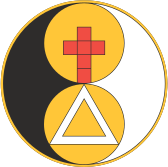Origins Matter
Where does the Golden Dawn come from? We know about the Cypher Manuscripts, and we know the Founders developed them, in several stages, into the rituals we know today. We also know there has to be more of a backstory.
Analysis of the the Order’s material, namely the rites, practices, and teachings, when compared with the rest of the western magical tradition, discloses its more immediate sources with confidence. Clearly, the Order is founded on Agrippa. A careful read of the Three Books of Occult Philosophy (TBOP) shows the source material that the Golden Dawn implemented to build the Order. Agrippa is especially important in that it is he who produces in the Three Books a synthesis of the truly ancient practices and understandings with Hebrew esotericism, producing the Qabalah as we magicians use it today. It is amazing how much of the Qabalah we use today is exactly the same set of usages and attributions as Agrippa gives, and interesting where it varies as well.
In a more practical vein, the Knowledge lectures as we have them are quite thin, having no explanatory text. But Agrippa supplies this. Compare the initial chapters of TBOP with the Knowledge Lectures and you will see that they substantially parallel each other, Agrippa providing a detailed, if dated, explanation. It is even better and easier to see in Purdue’s new rendering of the Agrippa’s Latin. (I can’t wait for him to finish the other two Books!) The OSOGD is doing some analysis of the text vs our curriculum and plans to publish our findings here to that the Three Books can be more effectively integrated into our teaching process.
The story of our origins does not end with Agrippa. He is the great synthesizer of the Renaissance, drawing together the best work of his day, quoting liberally from Ficino, Pico, and many another thinker of his day and the generation or so before him. From his synthesis, his Three Books, most of the western magical system depends. However, these worthies did not create the material Agrippa put in his Philosophy. What drove the revolution that was the Renaissance was the recovery of ancient, mostly Greek writings, religion, philosophy, and practice. Cosimo de Medici collected and had Ficino translate most of Plato, which was lost to the west, the Hermetic Corpus, the Orphic Hymns, the Chaldean Oracles, Plotinus, Porphyry, Iamblichus, and Proclus, and other ancient writers. This flood of vibrant culture burst the seams of the Medieval world and laid the groundwork for the Modern age. It is in these sources that our origins come.
From this list of texts I’m sure you can appreciate the importance of them begin translated and made available to eventually form the Golden Dawn. What is somewhat less understood is that the primary explanations of our magical technology is embedded in them as well. Two specific texts are vital and necessary to transmit what we call magic today, and without which we would merely have a collection of spell craft much like the Greek Magical Papyri. The longer and more important was called De Mysteriis by Ficino, even though it has nothing to do with the Mysteries. This is Iamblichus’ defense and explanation of theurgy, the last great florescence of religiosity in the pre-Christain world. In it he explains the importance of invocation, and the stages of maturation in divine relations, how to distinguish the grades of entities from lesser spirits to the Great Gods, how to interpret symbolism, how to find your Personal Deamon (Holy Guardian Angel), how to “guide the light” (think middle pillar), how to advance on the path, and what results you would get if you do the work. The shorter and better known work is Proclus, “On the hieratic art” or “On Sacrifice” as it is variously called. This is a summary of a longer Proclus work, probably made by the Byzantine Michael Psellus. This gives the shortest single justification for our practices, the theory of correspondences and a variety of other aspects of our work, all of which find themselves into Ficino’s Three Books of Life, which itself is the first reacquisition of the ancient ways of theurgy in the Christian world. (Not to totally ignore pseudo-Dionysis, who was Proclus’ student, and his influence on interpreting the Mass as a theurgic rite.)
As a Pagan, finally scraping away the layers of Christianity and seeing the bright and lovely basis for our practices as they were understood in the ancient world is so inspiring. Undistorted by monotheism, imperial politics, or the bizarre doctrines of Christianity, theurgy takes its place as a profound deepening of ancient religious practice. It justifies and explains the worship of the ancient Gods, shows how we can unite ourselves with Them, and advance ourselves spiritually. The OSOGD will be reviewing our curriculum and adjusting it to take advantage of this deep running stream of spirituality.
